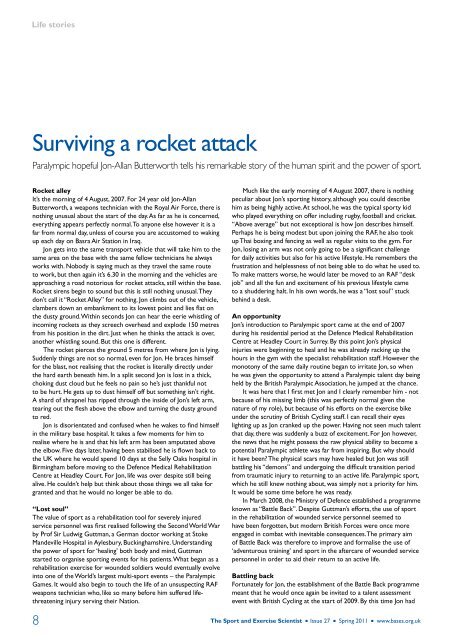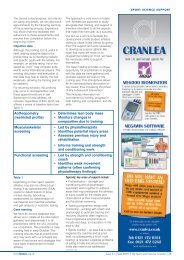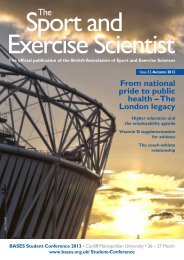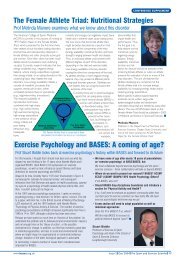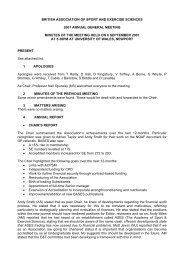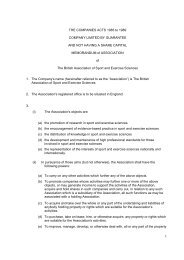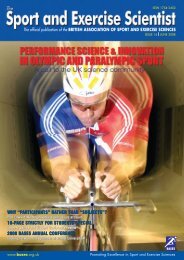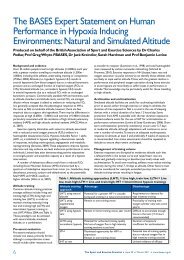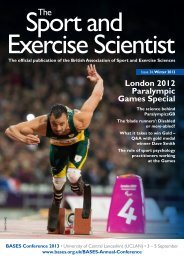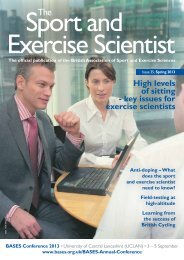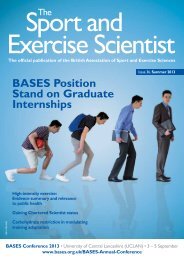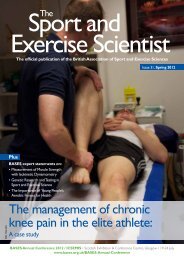The Sport and Exercise Scientist Issue 27, Spring 2011 - BASES
The Sport and Exercise Scientist Issue 27, Spring 2011 - BASES
The Sport and Exercise Scientist Issue 27, Spring 2011 - BASES
- No tags were found...
You also want an ePaper? Increase the reach of your titles
YUMPU automatically turns print PDFs into web optimized ePapers that Google loves.
Life storiesSurviving a rocket attackParalympic hopeful Jon-Allan Butterworth tells his remarkable story of the human spirit <strong>and</strong> the power of sport.Rocket alleyIt’s the morning of 4 August, 2007. For 24 year old Jon-AllanButterworth, a weapons technician with the Royal Air Force, there isnothing unusual about the start of the day. As far as he is concerned,everything appears perfectly normal. To anyone else however it is afar from normal day, unless of course you are accustomed to wakingup each day on Basra Air Station in Iraq.Jon gets into the same transport vehicle that will take him to thesame area on the base with the same fellow technicians he alwaysworks with. Nobody is saying much as they travel the same routeto work, but then again it’s 6.30 in the morning <strong>and</strong> the vehicles areapproaching a road notorious for rocket attacks, still within the base.Rocket sirens begin to sound but this is still nothing unusual. <strong>The</strong>ydon’t call it “Rocket Alley” for nothing. Jon climbs out of the vehicle,clambers down an embankment to its lowest point <strong>and</strong> lies flat onthe dusty ground. Within seconds Jon can hear the eerie whistling ofincoming rockets as they screech overhead <strong>and</strong> explode 150 metresfrom his position in the dirt. Just when he thinks the attack is over,another whistling sound. But this one is different.<strong>The</strong> rocket pierces the ground 5 metres from where Jon is lying.Suddenly things are not so normal, even for Jon. He braces himselffor the blast, not realising that the rocket is literally directly underthe hard earth beneath him. In a split second Jon is lost in a thick,choking dust cloud but he feels no pain so he’s just thankful notto be hurt. He gets up to dust himself off but something isn’t right.A shard of shrapnel has ripped through the inside of Jon’s left arm,tearing out the flesh above the elbow <strong>and</strong> turning the dusty groundto red.Jon is disorientated <strong>and</strong> confused when he wakes to find himselfin the military base hospital. It takes a few moments for him torealise where he is <strong>and</strong> that his left arm has been amputated abovethe elbow. Five days later, having been stabilised he is flown back tothe UK where he would spend 10 days at the Selly Oaks hospital inBirmingham before moving to the Defence Medical RehabilitationCentre at Headley Court. For Jon, life was over despite still beingalive. He couldn’t help but think about those things we all take forgranted <strong>and</strong> that he would no longer be able to do.“Lost soul”<strong>The</strong> value of sport as a rehabilitation tool for severely injuredservice personnel was first realised following the Second World Warby Prof Sir Ludwig Guttman, a German doctor working at StokeM<strong>and</strong>eville Hospital in Aylesbury, Buckinghamshire. Underst<strong>and</strong>ingthe power of sport for ‘healing’ both body <strong>and</strong> mind, Guttmanstarted to organise sporting events for his patients. What began as arehabilitation exercise for wounded soldiers would eventually evolveinto one of the World’s largest multi-sport events – the ParalympicGames. It would also begin to touch the life of an unsuspecting RAFweapons technician who, like so many before him suffered lifethreateninginjury serving their Nation.Much like the early morning of 4 August 2007, there is nothingpeculiar about Jon’s sporting history, although you could describehim as being highly active. At school, he was the typical sporty kidwho played everything on offer including rugby, football <strong>and</strong> cricket.“Above average” but not exceptional is how Jon describes himself.Perhaps he is being modest but upon joining the RAF, he also tookup Thai boxing <strong>and</strong> fencing as well as regular visits to the gym. ForJon, losing an arm was not only going to be a significant challengefor daily activities but also for his active lifestyle. He remembers thefrustration <strong>and</strong> helplessness of not being able to do what he used to.To make matters worse, he would later be moved to an RAF “deskjob” <strong>and</strong> all the fun <strong>and</strong> excitement of his previous lifestyle cameto a shuddering halt. In his own words, he was a “lost soul” stuckbehind a desk.An opportunityJon’s introduction to Paralympic sport came at the end of 2007during his residential period at the Defence Medical RehabilitationCentre at Headley Court in Surrey. By this point Jon’s physicalinjuries were beginning to heal <strong>and</strong> he was already racking up thehours in the gym with the specialist rehabilitation staff. However themonotony of the same daily routine began to irritate Jon, so whenhe was given the opportunity to attend a Paralympic talent day beingheld by the British Paralympic Association, he jumped at the chance.It was here that I first met Jon <strong>and</strong> I clearly remember him - notbecause of his missing limb (this was perfectly normal given thenature of my role), but because of his efforts on the exercise bikeunder the scrutiny of British Cycling staff. I can recall their eyeslighting up as Jon cranked up the power. Having not seen much talentthat day, there was suddenly a buzz of excitement. For Jon however,the news that he might possess the raw physical ability to become apotential Paralympic athlete was far from inspiring. But why shouldit have been? <strong>The</strong> physical scars may have healed but Jon was stillbattling his “demons” <strong>and</strong> undergoing the difficult transition periodfrom traumatic injury to returning to an active life. Paralympic sport,which he still knew nothing about, was simply not a priority for him.It would be some time before he was ready.In March 2008, the Ministry of Defence established a programmeknown as “Battle Back”. Despite Guttman’s efforts, the use of sportin the rehabilitation of wounded service personnel seemed tohave been forgotten, but modern British Forces were once moreengaged in combat with inevitable consequences. <strong>The</strong> primary aimof Battle Back was therefore to improve <strong>and</strong> formalise the use of‘adventurous training’ <strong>and</strong> sport in the aftercare of wounded servicepersonnel in order to aid their return to an active life.Battling backFortunately for Jon, the establishment of the Battle Back programmemeant that he would once again be invited to a talent assessmentevent with British Cycling at the start of 2009. By this time Jon had8 <strong>The</strong> <strong>Sport</strong> <strong>and</strong> <strong>Exercise</strong> <strong>Scientist</strong> n <strong>Issue</strong> <strong>27</strong> n <strong>Spring</strong> <strong>2011</strong> n www.bases.org.uk


